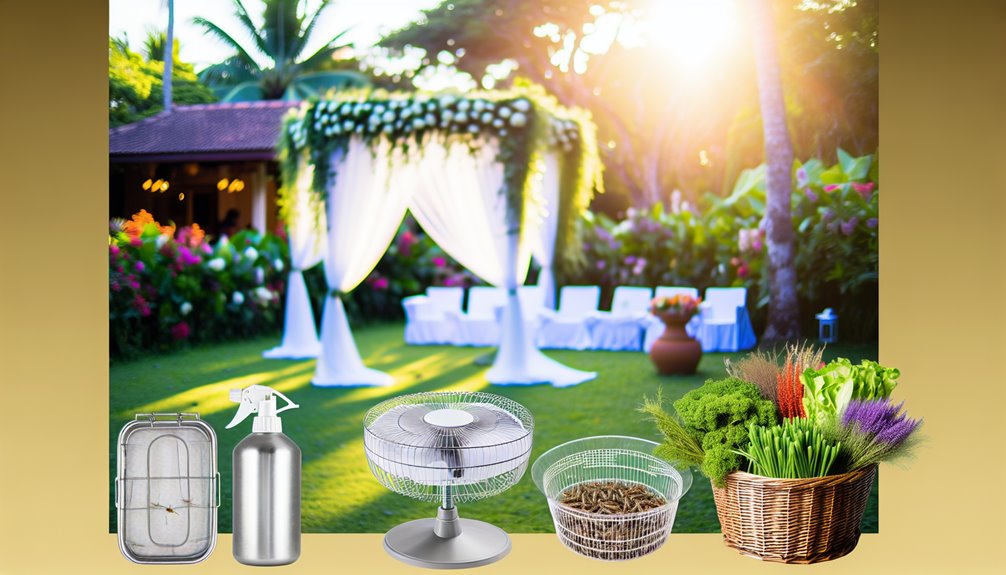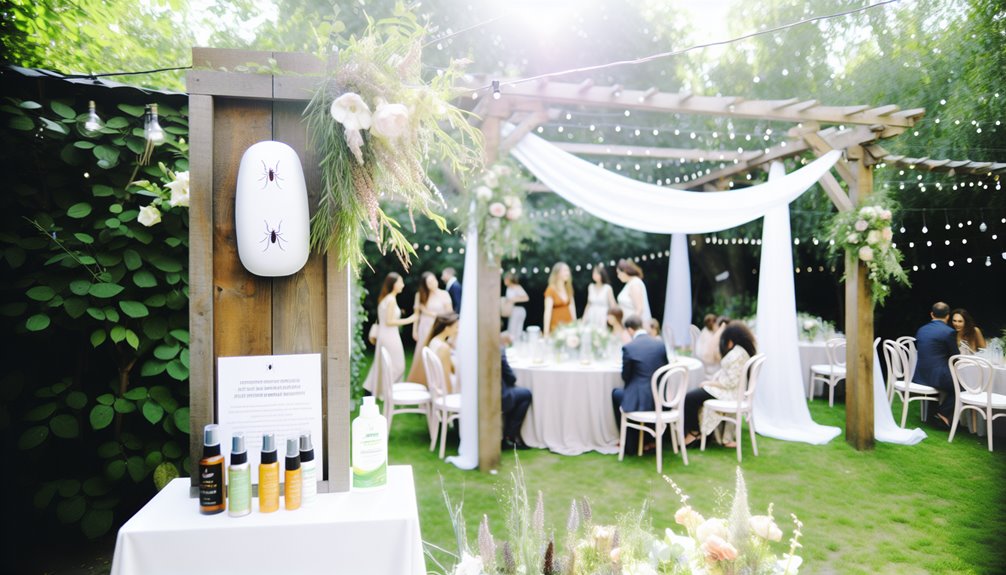Champagne toasts meet mosquito bites unless you plan with precision. You’ll start by mapping standing water, dense vegetation, and guest flow, then schedule larvicides and barrier sprays well ahead of the date. Choose EPA-registered products, verify label directions, and stage discreet repellent stations. Coordinate with neighbors, confirm local compliance, and assign a trained applicator for the event day. Fans, traps, and reapplication windows matter—and one timing mistake could undo everything. Here’s what to get right next.
Assess Your Backyard: Mosquito Risks, Hotspots, and Guest Flow

Before you book rentals or place décor, walk the property to identify mosquito risks, concentrating on standing water, dense vegetation, and shaded, wind-sheltered areas. Note clogged gutters, birdbaths, planters, toys, and tarps that permit mosquito breeding. Flag high risk areas near guest seating, bars, catering prep, photo spots, and restrooms. Map airflow and sun exposure; prioritize perimeters, hedges, and under-deck voids. Verify drainage directs water off hardscapes. Keep vegetation trimmed to improve ventilation and reduce harborage. Separate food service from foliage. Guarantee ADA-compliant paths avoid hotspots. Document findings, take photos, and mark no-spray zones for pollinators, edible beds, and water features.
Timeline to a Bite-Free Day: When to Schedule Each Treatment
A disciplined schedule reduces mosquito pressure and keeps you compliant and safe. Count back from the event date using the mosquito lifecycle. At minus 21–14 days, inspect, eliminate standing water, and deploy larval control per label. At minus 10–7 days, conduct the first barrier application; document product, rate, and weather. At minus 3–2 days, repeat per treatment frequency on the label, respecting re‑entry intervals and drift precautions. The day before, spot-treat high-risk foliage and shaded zones; verify ventilation and buffer distances. Event day morning, recheck for water, update logs, and post required notifications. Afterward, perform a compliance review and waste disposal.
Choose Your Strategy: Sprays, Traps, Fans, and Natural Repellents

Whether you’re managing a small patio or a full lawn, select controls that complement each other and comply with labels and local regulations. Match spray types to targets: residual barrier sprays for shaded vegetation, space sprays for short-term knockdown, and larvicides for standing water you can’t drain. Verify reentry intervals and wind limits. Place traps downwind from guests; choose trap locations near shade, hedges, or water features, not at seating or catering. Add directional fans to disrupt flight paths along perimeters and buffet lines. Use natural repellents strategically—treat entry points and staging areas—and document applications to support safety briefings and vendor coordination.
Products That Work: Safe, Wedding-Ready Options for People and Pets
Start with EPA-registered products suited to mixed-age guests, pets, and food service, and verify each label for site, pest, and reentry limits. Choose skin-applied actives like DEET, picaridin, or oil of lemon eucalyptus; follow age restrictions and contact-time directions. For clothing, use permethrin-treated fabrics—never apply to skin. Select ready-to-use perimeter sprays with clear pre-harvest and reentry intervals when food is nearby. Emphasize pet safety: avoid pyrethrin foggers around fish or birds; restrict access until dry. Complement with natural repellents containing citronella or lemongrass where labels permit. Document products, lot numbers, and application times to demonstrate compliance.
On-the-Day Game Plan: Setups, Signage, and Discreet Reapplication

With products selected and labels verified, put the wedding-day controls into motion: stage repellent stations at guest arrival, bar, and restroom areas; pre-position permethrin-treated blankets or wraps in a clearly marked bin; and set out discreet tabletop fans to disrupt mosquito flight near food and seating. Assign a trained attendant to monitor inventories, timing, and setup logistics. Use clear, courteous signage placement: “Apply repellent to exposed skin only,” “Do not use on infants,” and “Return wraps after use.” Schedule quiet reapplications per label intervals, away from guests and food. Wear gloves, avoid drift, document times, and secure products between uses.
Eco-Smart and Neighbor-Friendly: Compliance, Communication, and Cleanup
Even as you prioritize guest comfort, align mosquito control with local regulations and low-impact practices. Verify product labels, permissible application methods, and setback distances from water, pollinator habitat, and property lines. Choose targeted treatments, integrate eco friendly practices, and document lot numbers, timing, and weather.
Notify neighbors early. Share schedules, product types, and reentry intervals to foster community involvement and reduce complaints. Provide opt-out zones near sensitive areas.
On event day, post compliant signage and cordon off treated zones until dry. Afterward, remove traps, collect litter, and store chemicals securely. Dispose of rinsate per label and local hazardous-waste guidance.
Conclusion
As the owner of Mosquito Eliminators of South MS, I want to ensure that your backyard wedding is not only beautiful but also free from pesky interruptions. With careful planning and the right treatments, we can help create a comfortable space for you and your guests to enjoy your special day. If you’d like to learn more about our services or have any questions, I invite you to visit us at mosquitoeliminatorsms.com or give us a call at (601) 336-2277. We’re here to help you make your celebration a memorable and enjoyable experience, and I can’t wait to assist you in creating a bite-free atmosphere for your big day!

